Temperature and Precipitation Bias Patterns in a Dynamical Downscaling Procedure over Europe during the Period 1951–2010
Abstract
:1. Introduction
2. Materials and Methods
2.1. The Earth System Model
2.2. The Regional Climate Model
2.3. Observational Data
2.4. Modelling Setup and Approach
3. Results
3.1. Temperature
3.1.1. Mean Temperature Change and Bias
3.1.2. Days Per Month with Mean Temperature over 25 °C
3.2. Precipitation
3.2.1. Mean Precipitation
3.2.2. Days Per Month with Mean Daily Precipitation above 5 mm
4. Discussion and Conclusions
Author Contributions
Funding
Institutional Review Board Statement
Informed Consent Statement
Data Availability Statement
Acknowledgments
Conflicts of Interest
References
- Masson-Delmotte, V.; Zhai, P.; Pirani, A.; Connors, S.L.; Péan, C.; Berger, S.; Caud, N.; Chen, Y.; Goldfarb, L.; Gomis, M.I.; et al. (Eds.) IPCC, 2021: Climate Change 2021: The Physical Science Basis. Contribution of Working Group I to the Sixth Assessment Report of the Intergovernmental Panel on Climate Change; Cambridge University Press: Cambridge, UK; New York, NY, USA, 2021; in press. [Google Scholar] [CrossRef]
- Giorgi, F.; Gutowski, W.J. Coordinated Experiments for Projections of Regional Climate Change. Curr. Clim. Change Rep. 2016, 2, 202–210. [Google Scholar] [CrossRef] [Green Version]
- Knutti, R.; Sedláček, J. Robustness and Uncertainties in the New CMIP5 Climate Model Projections. Nat. Clim. Chang. 2013, 3, 369–373. [Google Scholar] [CrossRef]
- Christensen, J.H.; Carter, T.R.; Rummukainen, M.; Amanatidis, G. Evaluating the Performance and Utility of Regional Climate Models: The PRUDENCE Project. Clim. Chang. 2007, 81, 1–6. [Google Scholar] [CrossRef]
- Beniston, M.; Goyette, S. Changes in Variability and Persistence of Climate in Switzerland: Exploring 20th Century Observations and 21st Century Simulations. Glob. Planet. Chang. 2007, 57, 1–15. [Google Scholar] [CrossRef] [Green Version]
- Christensen, J.H.; Carter, T.R.; Giorgi, F. PRUDENCE Employs New Methods to Assess European Climate Change. Eos Trans. Am. Geophys. Union 2002, 83, 147. [Google Scholar] [CrossRef]
- Christensen, J.H.; Christensen, O.B. A Summary of the PRUDENCE Model Projections of Changes in European Climate by the End of This Century. Clim. Chang. 2007, 81, 7–30. [Google Scholar] [CrossRef]
- Déqué, M.; Rowell, D.P.; Lüthi, D.; Giorgi, F.; Christensen, J.H.; Rockel, B.; Jacob, D.; Kjellström, E.; de Castro, M.; van den Hurk, B. An Intercomparison of Regional Climate Simulations for Europe: Assessing Uncertainties in Model Projections. Clim. Chang. 2007, 81, 53–70. [Google Scholar] [CrossRef]
- ENSEMBLES: Climate Change and Its Impacts: Summary of Research and Results from the ENSEMBLES Project—European Environment Agency. Available online: https://www.eea.europa.eu/data-and-maps/indicators/global-and-european-temperature-1/ensembles-climate-change-and-its (accessed on 9 July 2022).
- Doblas-Reyes, F.J.; Weisheimer, A.; Déqué, M.; Keenlyside, N.; McVean, M.; Murphy, J.M.; Rogel, P.; Smith, D.; Palmer, T.N. Addressing Model Uncertainty in Seasonal and Annual Dynamical Ensemble Forecasts. Q. J. R. Meteorol. Soc. 2009, 135, 1538–1559. [Google Scholar] [CrossRef] [Green Version]
- Weisheimer, A.; Doblas-Reyes, F.J.; Palmer, T.N.; Alessandri, A.; Arribas, A.; Déqué, M.; Keenlyside, N.; MacVean, M.; Navarra, A.; Rogel, P. ENSEMBLES: A New Multi-Model Ensemble for Seasonal-to-Annual Predictions—Skill and Progress beyond DEMETER in Forecasting Tropical Pacific SSTs. Geophys. Res. Lett. 2009, 36, L21711. [Google Scholar] [CrossRef] [Green Version]
- Jacob, D.; Bärring, L.; Christensen, O.B.; Christensen, J.H.; de Castro, M.; Déqué, M.; Giorgi, F.; Hagemann, S.; Hirschi, M.; Jones, R.; et al. An Inter-Comparison of Regional Climate Models for Europe: Model Performance in Present-Day Climate. Clim. Chang. 2007, 81, 31–52. [Google Scholar] [CrossRef]
- Kotlarski, S.; Keuler, K.; Christensen, O.B.; Colette, A.; Déqué, M.; Gobiet, A.; Goergen, K.; Jacob, D.; Lüthi, D.; Van Meijgaard, E.; et al. Regional Climate Modeling on European Scales: A Joint Standard Evaluation of the EURO-CORDEX RCM Ensemble. Geosci. Model Dev. 2014, 7, 1297–1333. [Google Scholar] [CrossRef] [Green Version]
- Jacob, D.; Petersen, J.; Eggert, B.; Alias, A.; Christensen, O.B.; Bouwer, L.M.; Braun, A.; Colette, A.; Déqué, M.; Georgievski, G.; et al. EURO-CORDEX: New High-Resolution Climate Change Projections for European Impact Research. Reg. Environ. Chang. 2014, 14, 563–578. [Google Scholar] [CrossRef]
- Ruti, P.M.; Somot, S.; Giorgi, F.; Dubois, C.; Flaounas, E.; Obermann, A.; Dell’Aquila, A.; Pisacane, G.; Harzallah, A.; Lombardi, E.; et al. Med-CORDEX Initiative for Mediterranean Climate Studies. Bull. Am. Meteorol. Soc. 2016, 97, 1187–1208. [Google Scholar] [CrossRef] [Green Version]
- Kjellström, E.; Boberg, F.; Castro, M.; Christensen, J.H.; Nikulin, G.; Sánchez, E. Daily and Monthly Temperature and Precipitation Statistics as Performance Indicators for Regional Climate Models. Clim. Res. 2010, 44, 135–150. [Google Scholar] [CrossRef]
- Lenderink, G. Exploring Metrics of Extreme Daily Precipitation in a Large Ensemble of Regional Climate Model Simulations. Clim. Res. 2010, 44, 151–166. [Google Scholar] [CrossRef]
- Lorenz, P.; Jacob, D. Validation of Temperature Trends in the ENSEMBLES Regional Climate Model Runs Driven by ERA40. Clim. Res. 2010, 44, 167–177. [Google Scholar] [CrossRef]
- Sanchez-Gomez, E.; Somot, S.; Déqué, M. Ability of an Ensemble of Regional Climate Models to Reproduce Weather Regimes over Europe-Atlantic during the Period 1961–2000. Clim. Dyn. 2009, 33, 723–736. [Google Scholar] [CrossRef]
- Sanchez-Gomez, E.; Somot, S.; Josey, S.A.; Dubois, C.; Elguindi, N.; Déqué, M. Evaluation of Mediterranean Sea Water and Heat Budgets Simulated by an Ensemble of High Resolution Regional Climate Models. Clim. Dyn. 2011, 37, 2067–2086. [Google Scholar] [CrossRef] [Green Version]
- Vautard, R.; Gobiet, A.; Jacob, D.; Belda, M.; Colette, A.; Déqué, M.; Fernández, J.; García-Díez, M.; Goergen, K.; Güttler, I.; et al. The Simulation of European Heat Waves from an Ensemble of Regional Climate Models within the EURO-CORDEX Project. Clim. Dyn. 2013, 41, 2555–2575. [Google Scholar] [CrossRef]
- Aalbers, E.E.; Lenderink, G.; van Meijgaard, E.; van den Hurk, B.J.J.M. Local-Scale Changes in Mean and Heavy Precipitation in Western Europe, Climate Change or Internal Variability? Clim. Dyn. 2018, 50, 4745–4766. [Google Scholar] [CrossRef] [Green Version]
- Christensen, O.B.; Kjellström, E. Partitioning Uncertainty Components of Mean Climate and Climate Change in a Large Ensemble of European Regional Climate Model Projections. Clim. Dyn. 2020, 54, 4293–4308. [Google Scholar] [CrossRef]
- Vautard, R.; Kadygrov, N.; Iles, C.; Boberg, F.; Buonomo, E.; Bülow, K.; Coppola, E.; Corre, L.; van Meijgaard, E.; Nogherotto, R.; et al. Evaluation of the Large EURO-CORDEX Regional Climate Model Ensemble. J. Geophys. Res. Atmos. 2021, 126, e2019JD032344. [Google Scholar] [CrossRef]
- Kendon, E.J.; Jones, R.G.; Kjellström, E.; Murphy, J.M. Using and Designing GCM–RCM Ensemble Regional Climate Projections. J. Clim. 2010, 23, 6485–6503. [Google Scholar] [CrossRef]
- Sørland, S.L.; Schär, C.; Lüthi, D.; Kjellström, E. Bias Patterns and Climate Change Signals in GCM-RCM Model Chains. Environ. Res. Lett. 2018, 13, 074017. [Google Scholar] [CrossRef]
- Wilby, R.L.; Wigley, T.M.L. Downscaling General Circulation Model Output: A Review of Methods and Limitations. Prog. Phys. Geogr. Earth Environ. 1997, 21, 530–548. [Google Scholar] [CrossRef]
- Maraun, D. Bias Correction, Quantile Mapping, and Downscaling: Revisiting the Inflation Issue. J. Clim. 2013, 26, 2137–2143. [Google Scholar] [CrossRef] [Green Version]
- Russell, G.L.; Miller, J.R.; Rind, D. A Coupled Atmosphere-ocean Model for Transient Climate Change Studies. Atmos.-Ocean 1995, 33, 683–730. [Google Scholar] [CrossRef]
- Hansen, J.; Sato, M.; Ruedy, R.; Kharecha, P.; Lacis, A.; Miller, R.; Nazarenko, L.; Lo, K.; Schmidt, G.A.; Russell, G.; et al. Climate Simulations for 1880–2003 with GISS ModelE. Clim. Dyn. 2007, 29, 661–696. [Google Scholar] [CrossRef] [Green Version]
- Schmidt, G.A.; Ruedy, R.; Hansen, J.E.; Aleinov, I.; Bell, N.; Bauer, M.; Bauer, S.; Cairns, B.; Canuto, V.; Cheng, Y.; et al. Present-Day Atmospheric Simulations Using GISS ModelE: Comparison to In Situ, Satellite, and Reanalysis Data. J. Clim. 2006, 19, 153–192. [Google Scholar] [CrossRef]
- Miller, R.L.; Schmidt, G.A.; Nazarenko, L.S.; Tausnev, N.; Bauer, S.E.; DelGenio, A.D.; Kelley, M.; Lo, K.K.; Ruedy, R.; Shindell, D.T.; et al. CMIP5 Historical Simulations (1850–2012) with GISS ModelE2. J. Adv. Model. Earth Syst. 2014, 6, 441–478. [Google Scholar] [CrossRef]
- Schmidt, G.A.; Kelley, M.; Nazarenko, L.; Ruedy, R.; Russell, G.L.; Aleinov, I.; Bauer, M.; Bauer, S.E.; Bhat, M.K.; Bleck, R.; et al. Configuration and Assessment of the GISS ModelE2 Contributions to the CMIP5 Archive. J. Adv. Model. Earth Syst. 2014, 6, 141–184. [Google Scholar] [CrossRef]
- Nazarenko, L.; Schmidt, G.A.; Miller, R.L.; Tausnev, N.; Kelley, M.; Ruedy, R.; Russell, G.L.; Aleinov, I.; Bauer, M.; Bauer, S.; et al. Future Climate Change under RCP Emission Scenarios with GISS ModelE2. J. Adv. Model. Earth Syst. 2015, 7, 244–267. [Google Scholar] [CrossRef] [Green Version]
- Kim, Y.; Moorcroft, P.R.; Aleinov, I.; Puma, M.J.; Kiang, N.Y. Variability of Phenology and Fluxes of Water and Carbon with Observed and Simulated Soil Moisture in the Ent Terrestrial Biosphere Model (Ent TBM Version 1.0.1.0.0). Geosci. Model Dev. 2015, 8, 3837–3865. [Google Scholar] [CrossRef] [Green Version]
- Del Genio, A.D.; Yao, M.-S. Efficient Cumulus Parameterization for Long-Term Climate Studies: The GISS Scheme. In The Representation of Cumulus Convection in Numerical Models; Emanuel, K.A., Raymond, D.J., Eds.; American Meteorological Society: Boston, MA, USA, 1993; pp. 181–184. ISBN 978-1-935704-13-3. [Google Scholar]
- Del Genio, A.D.; Yao, M.-S.; Kovari, W.; Lo, K.K.-W. A Prognostic Cloud Water Parameterization for Global Climate Models. J. Clim. 1996, 9, 270–304. [Google Scholar] [CrossRef] [Green Version]
- Kim, D.; Sobel, A.H.; Del Genio, A.D.; Chen, Y.; Camargo, S.J.; Yao, M.-S.; Kelley, M.; Nazarenko, L. The Tropical Subseasonal Variability Simulated in the NASA GISS General Circulation Model. J. Clim. 2012, 25, 4641–4659. [Google Scholar] [CrossRef]
- Kim, D.; Del Genio, A.D.; Yao, M.-S. Moist convection scheme in ModelE2, 2011, technical report, NASA Goddard Inst. for Space Stud. arXiv 2013, arXiv:1312.7496. [Google Scholar]
- Skamarock, W.C.; Klemp, J.B.; Dudhia, J.; Gill, D.O.; Barker, D.M.; Wang, W.; Powers, J.G. A Description of the Advanced Research WRF Version 3; National Center for Atmospheric Research: Boulder, CO, USA, 2008. [Google Scholar] [CrossRef]
- Powers, J.G.; Klemp, J.B.; Skamarock, W.C.; Davis, C.A.; Dudhia, J.; Gill, D.O.; Coen, J.L.; Gochis, D.J.; Ahmadov, R.; Peckham, S.E.; et al. The Weather Research and Forecasting Model: Overview, System Efforts, and Future Directions. Bull. Am. Meteorol. Soc. 2017, 98, 1717–1737. [Google Scholar] [CrossRef]
- Skamarock, W.C.; Klemp, J.B.; Dudhia, J.; Gill, D.O.; Liu, Z.; Berner, J.; Wang, W.; Powers, J.G.; Duda, M.G.; Barker, D.M.; et al. A Description of the Advanced Research WRF Model Version 4; National Center for Atmospheric Research: Boulder, CO, USA, 2019. [Google Scholar]
- Soares, P.M.M.; Cardoso, R.M.; Miranda, P.M.A.; de Medeiros, J.; Belo-Pereira, M.; Espirito-Santo, F. WRF High Resolution Dynamical Downscaling of ERA-Interim for Portugal. Clim. Dyn. 2012, 39, 2497–2522. [Google Scholar] [CrossRef]
- Cardoso, R.M.; Soares, P.M.M.; Miranda, P.M.A.; Belo-Pereira, M. WRF High Resolution Simulation of Iberian Mean and Extreme Precipitation Climate. Int. J. Climatol. 2013, 33, 2591–2608. [Google Scholar] [CrossRef]
- Katragkou, E.; Garciá-Diéz, M.; Vautard, R.; Sobolowski, S.; Zanis, P.; Alexandri, G.; Cardoso, R.M.; Colette, A.; Fernandez, J.; Gobiet, A.; et al. Regional Climate Hindcast Simulations within EURO-CORDEX: Evaluation of a WRF Multi-Physics Ensemble. Geosci. Model Dev. 2015, 8, 603–618. [Google Scholar] [CrossRef] [Green Version]
- Knist, S.; Goergen, K.; Simmer, C. Evaluation and Projected Changes of Precipitation Statistics in Convection-Permitting WRF Climate Simulations over Central Europe. Clim. Dyn. 2020, 55, 325–341. [Google Scholar] [CrossRef] [Green Version]
- Pavlidis, V.; Katragkou, E.; Prein, A.; Georgoulias, A.K.; Kartsios, S.; Zanis, P.; Karacostas, T. Investigating the Sensitivity to Resolving Aerosol Interactions in Downscaling Regional Model Experiments with WRFv3.8.1 over Europe. Geosci. Model Dev. 2020, 13, 2511–2532. [Google Scholar] [CrossRef]
- Stergiou, I.; Tagaris, E.; Sotiropoulou, R.-E.P. Investigating the WRF Temperature and Precipitation Performance Sensitivity to Spatial Resolution over Central Europe. Atmosphere 2021, 12, 278. [Google Scholar] [CrossRef]
- Jerez, S.; López-Romero, J.M.; Turco, M.; Lorente-Plazas, R.; Gómez-Navarro, J.J.; Jiménez-Guerrero, P.; Montávez, J.P. On the Spin-Up Period in WRF Simulations Over Europe: Trade-Offs Between Length and Seasonality. J. Adv. Model. Earth Syst. 2020, 12, e2019MS001945. [Google Scholar] [CrossRef] [Green Version]
- Cornes, R.C.; van der Schrier, G.; van den Besselaar, E.J.; Jones, P.D. An Ensemble Version of the E-OBS Temperature and Precipitation Data Sets. J. Geophys. Res. Atmos. 2018, 123, 9391–9409. [Google Scholar] [CrossRef] [Green Version]
- Prein, A.F.; Gobiet, A.; Suklitsch, M.; Truhetz, H.; Awan, N.K.; Keuler, K.; Georgievski, G. Added Value of Convection Permitting Seasonal Simulations. Clim. Dyn. 2013, 41, 2655–2677. [Google Scholar] [CrossRef] [Green Version]
- Hofstra, N.; Haylock, M.; New, M.; Jones, P.D. Testing E-OBS European High-Resolution Gridded Data Set of Daily Precipitation and Surface Temperature. J. Geophys. Res. Atmos. 2009, 114, D21101. [Google Scholar] [CrossRef]
- Haylock, M.R.; Hofstra, N.; Klein Tank, A.M.G.; Klok, E.J.; Jones, P.D.; New, M. A European Daily High-Resolution Gridded Data Set of Surface Temperature and Precipitation for 1950–2006. J. Geophys. Res. Atmos. 2008, 113, D20119. [Google Scholar] [CrossRef] [Green Version]
- Kotlarski, S.; Szabó, P.; Herrera, S.; Räty, O.; Keuler, K.; Soares, P.M.; Cardoso, R.M.; Bosshard, T.; Pagé, C.; Boberg, F.; et al. Observational Uncertainty and Regional Climate Model Evaluation: A Pan-European Perspective. Int. J. Climatol. 2019, 39, 3730–3749. [Google Scholar] [CrossRef] [Green Version]
- Cardell, M.F.; Romero, R.; Amengual, A.; Homar, V.; Ramis, C. A Quantile–Quantile Adjustment of the EURO-CORDEX Projections for Temperatures and Precipitation. Int. J. Climatol. 2019, 39, 2901–2918. [Google Scholar] [CrossRef]
- Velikou, K.; Tolika, K.; Anagnostopoulou, C.; Zanis, P. Sensitivity Analysis of RegCM4 Model: Present Time Simulations over the Mediterranean. Theor. Appl. Climatol. 2019, 136, 1185–1208. [Google Scholar] [CrossRef]
- Min, E.; Hazeleger, W.; Van Oldenborgh, G.J.; Sterl, A. Evaluation of Trends in High Temperature Extremes in North-Western Europe in Regional Climate Models. Environ. Res. Lett. 2013, 8, 014011. [Google Scholar] [CrossRef] [Green Version]
- Nikulin, G.; Kjellström, E.; Hansson, U.; Strandberg, G.; Ullerstig, A. Evaluation and Future Projections of Temperature, Precipitation and Wind Extremes over Europe in an Ensemble of Regional Climate Simulations. Tellus A Dyn. Meteorol. Oceanogr. 2011, 63, 41–55. [Google Scholar] [CrossRef] [Green Version]
- Bellprat, O.; Kotlarski, S.; Lüthi, D.; Schär, C. Exploring Perturbed Physics Ensembles in a Regional Climate Model. J. Clim. 2012, 25, 4582–4599. [Google Scholar] [CrossRef]
- Hofstra, N.; New, M.; McSweeney, C. The Influence of Interpolation and Station Network Density on the Distributions and Trends of Climate Variables in Gridded Daily Data. Clim. Dyn. 2010, 35, 841–858. [Google Scholar] [CrossRef]
- Maraun, D.; Osborn, T.J.; Rust, H.W. The Influence of Synoptic Airflow on UK Daily Precipitation Extremes. Part II: Regional Climate Model and E-OBS Data Validation. Clim. Dyn. 2012, 39, 287–301. [Google Scholar] [CrossRef]
- Boris, S. Correction of Precipitation Measurements: ETH/IAHS/WMO Workshop on the Correction of Precipitation Measurements, Zurich, 1–3 April 1985; ETH/IAHS/WMO Workshop on the Correction of Precipitation Measurements, Ed.; Geographisches Institut, Eidgenössische Technische Hochschule: Zürich, Switzerland, 1986. [Google Scholar]
- Prein, A.F.; Gobiet, A. Impacts of Uncertainties in European Gridded Precipitation Observations on Regional Climate Analysis. Int. J. Climatol. 2017, 37, 305–327. [Google Scholar] [CrossRef]
- Schmidt, G.A.; Jungclaus, J.H.; Ammann, C.M.; Bard, E.; Braconnot, P.; Crowley, T.J.; Delaygue, G.; Joos, F.; Krivova, N.A.; Muscheler, R.; et al. Climate Forcing Reconstructions for Use in PMIP Simulations of the Last Millennium (v1.1). Geosci. Model Dev. 2012, 5, 185–191. [Google Scholar] [CrossRef] [Green Version]
- Mooney, P.A.; Mulligan, F.J.; Fealy, R. Evaluation of the Sensitivity of the Weather Research and Forecasting Model to Parameterization Schemes for Regional Climates of Europe over the Period 1990–95. J. Clim. 2013, 26, 1002–1017. [Google Scholar] [CrossRef] [Green Version]
- Hong, S.-Y.; Dudhia, J.; Chen, S.-H. A Revised Approach to Ice Microphysical Processes for the Bulk Parameterization of Clouds and Precipitation. Mon. Weather Rev. 2004, 132, 103–120. [Google Scholar] [CrossRef]
- Iacono, M.J.; Delamere, J.S.; Mlawer, E.J.; Shephard, M.W.; Clough, S.A.; Collins, W.D. Radiative Forcing by Long-Lived Greenhouse Gases: Calculations with the AER Radiative Transfer Models. J. Geophys. Res. Atmos. 2008, 113, D13103. [Google Scholar] [CrossRef]
- Hong, S.-Y.; Noh, Y.; Dudhia, J. A New Vertical Diffusion Package with an Explicit Treatment of Entrainment Processes. Mon. Weather Rev. 2006, 134, 2318–2341. [Google Scholar] [CrossRef] [Green Version]
- Kain, J.S. The Kain–Fritsch Convective Parameterization: An Update. J. Appl. Meteorol. Climatol. 2004, 43, 170–181. [Google Scholar] [CrossRef] [Green Version]
- Chen, F.; Mitchell, K.; Schaake, J.; Xue, Y.; Pan, H.-L.; Koren, V.; Duan, Q.Y.; Ek, M.; Betts, A. Modeling of Land Surface Evaporation by Four Schemes and Comparison with FIFE Observations. J. Geophys. Res. Atmos. 1996, 101, 7251–7268. [Google Scholar] [CrossRef] [Green Version]
- WMO. WMO Guidelines on the Calculation of Climate Normals, 2017 edition; WMO: Geneva, Switzerland, 2017; ISBN 978-92-63-11203-3. [Google Scholar]
- García-Díez, M.; Fernández, J.; Fita, L.; Yagüe, C. Seasonal Dependence of WRF Model Biases and Sensitivity to PBL Schemes over Europe. Q. J. R. Meteorol. Soc. 2013, 139, 501–514. [Google Scholar] [CrossRef] [Green Version]
- García-Díez, M.; Fernández, J.; Vautard, R. An RCM Multi-Physics Ensemble over Europe: Multi-Variable Evaluation to Avoid Error Compensation. Clim. Dyn. 2015, 45, 3141–3156. [Google Scholar] [CrossRef] [Green Version]
- Torma, C.; Coppola, E.; Giorgi, F.; Bartholy, J.; Pongrácz, R. Validation of a High-Resolution Version of the Regional Climate Model RegCM3 over the Carpathian Basin. J. Hydrometeorol. 2011, 12, 84–100. [Google Scholar] [CrossRef]
- Mystakidis, S.; Zanis, P.; Dogras, C.; Katragkou, E.; Pytharoulis, I.; Melas, D.; Anadranistakis, E.; Feidas, H. Optimization of a Regional Climate Model for High Resolution Simulations over Greece. In Advances in Meteorology, Climatology and Atmospheric Physics; Helmis, C.G., Nastos, P.T., Eds.; Springer: Berlin/Heidelberg, Germany, 2013; pp. 623–629. [Google Scholar]
- Evans, J.P.; Ekström, M.; Ji, F. Evaluating the Performance of a WRF Physics Ensemble over South-East Australia. Clim. Dyn. 2012, 39, 1241–1258. [Google Scholar] [CrossRef]
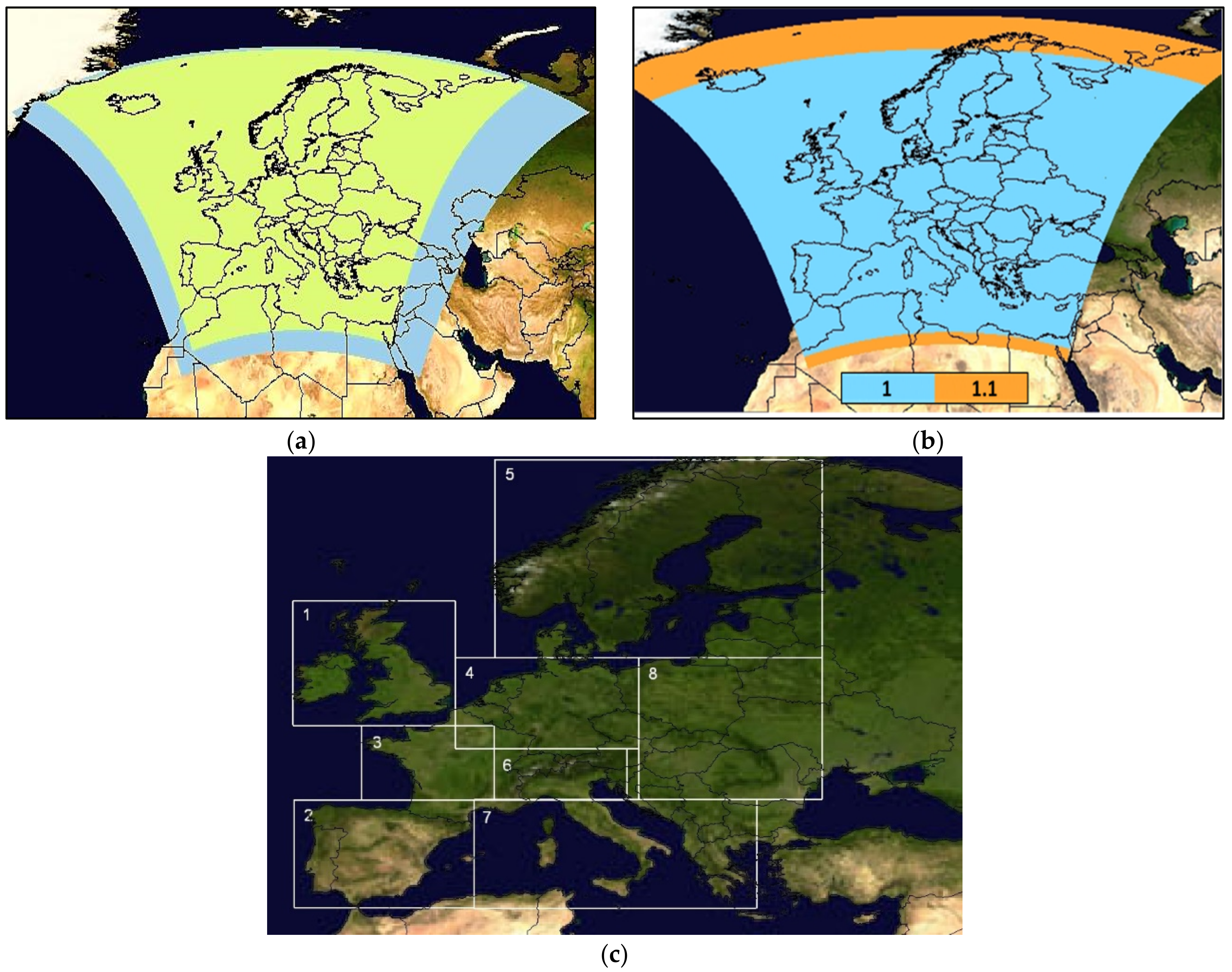

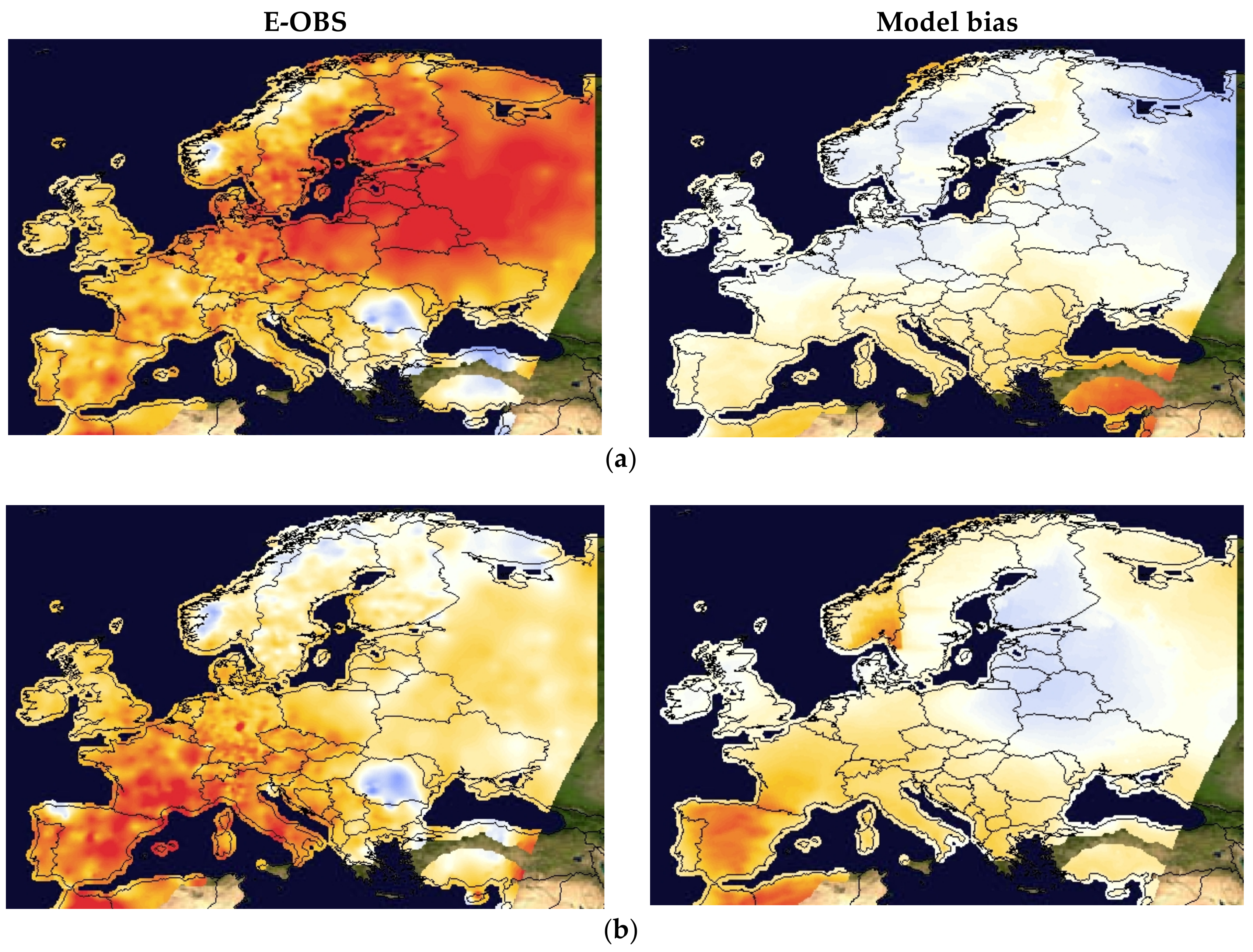


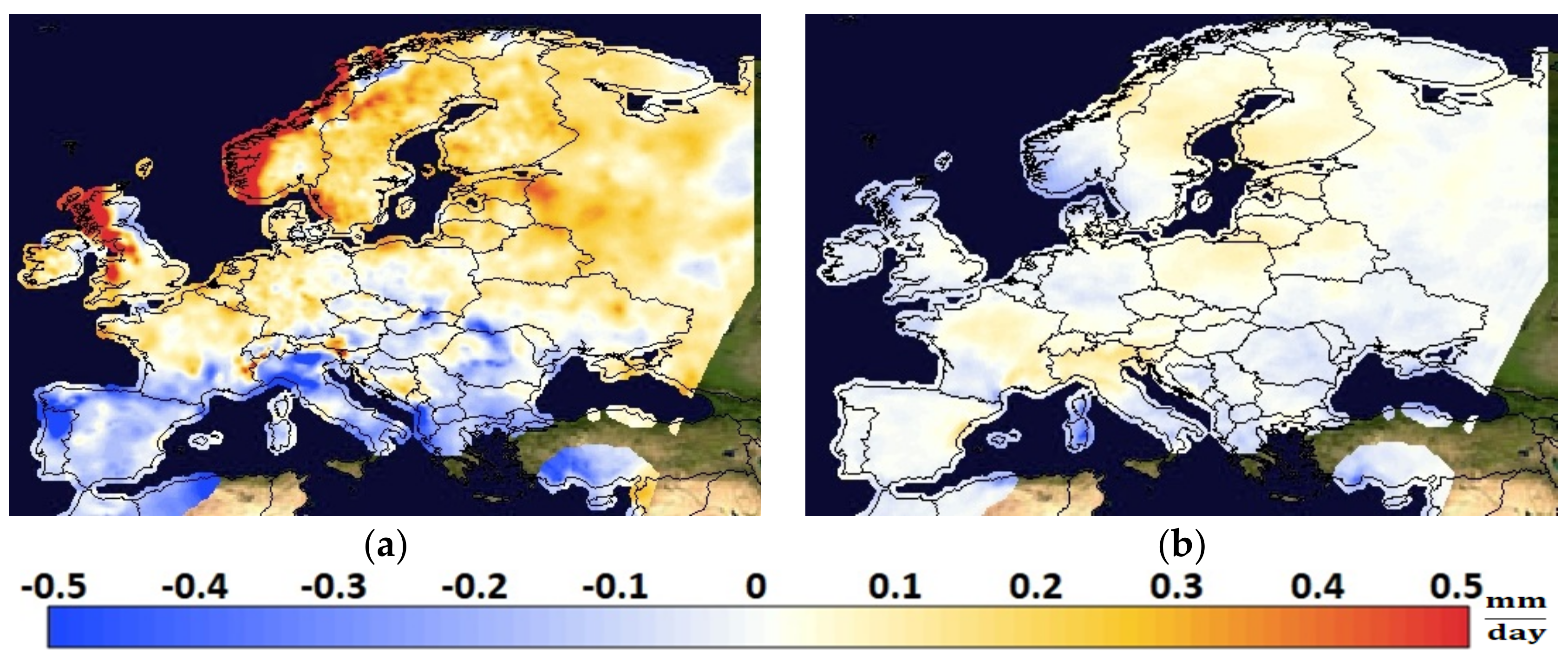
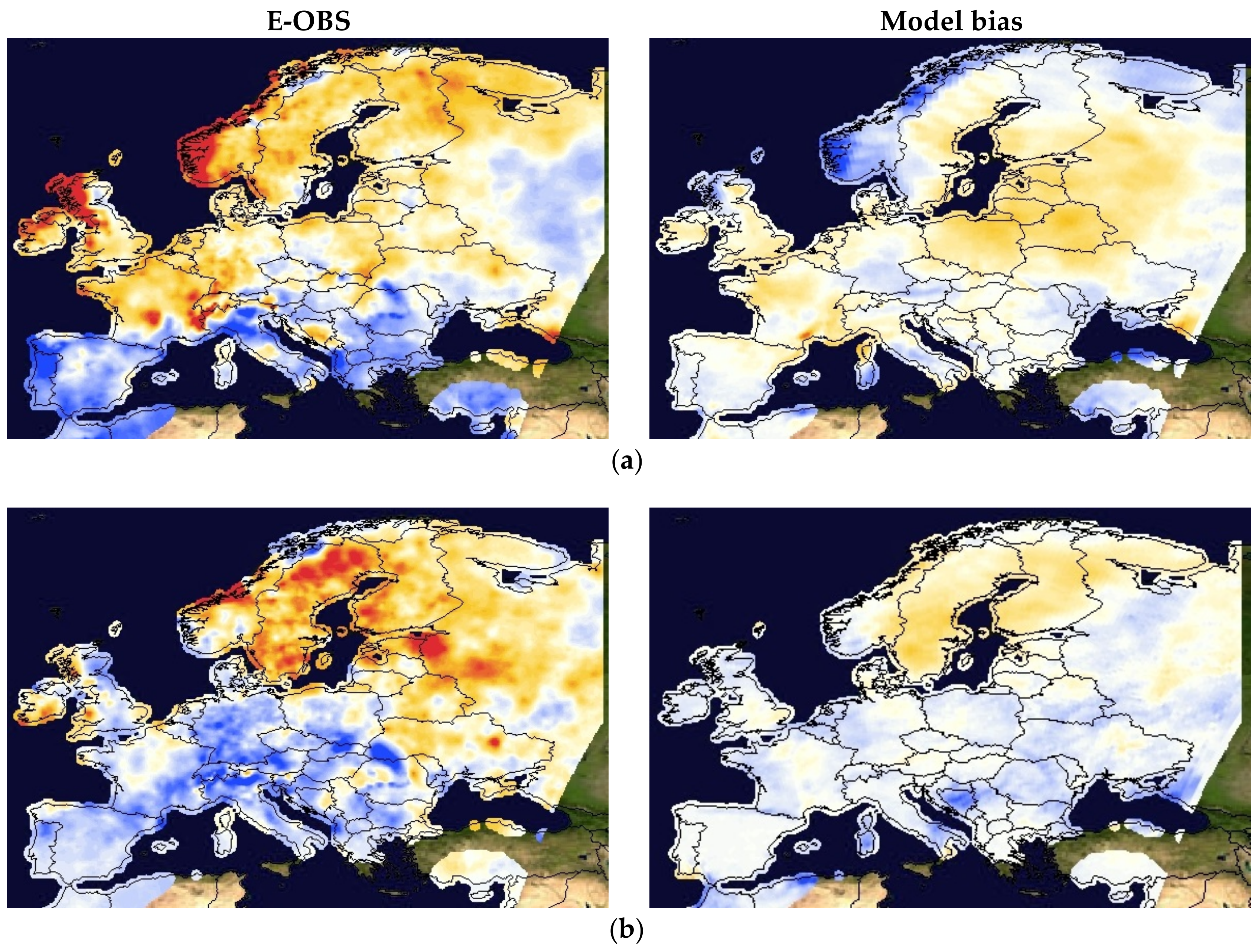
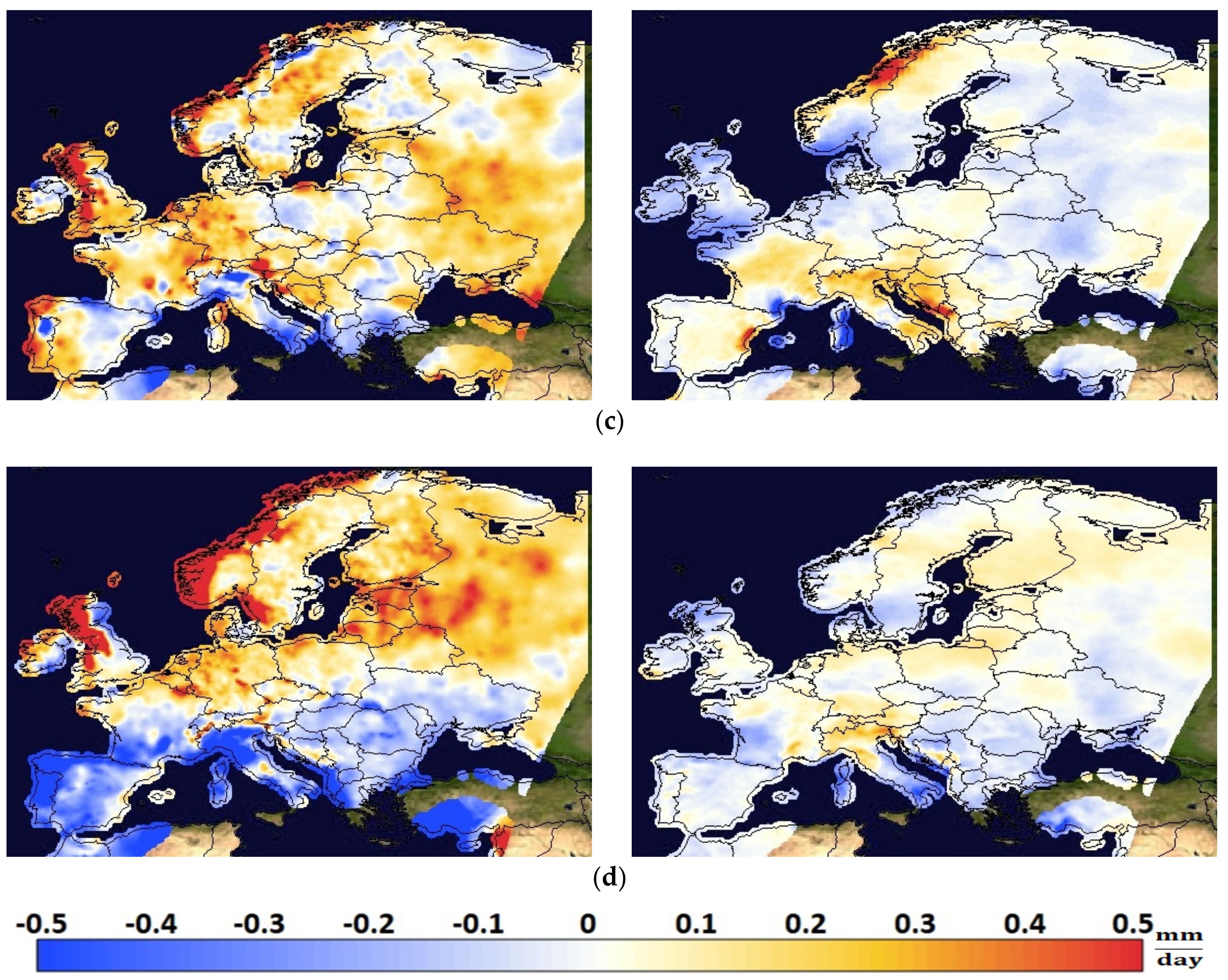
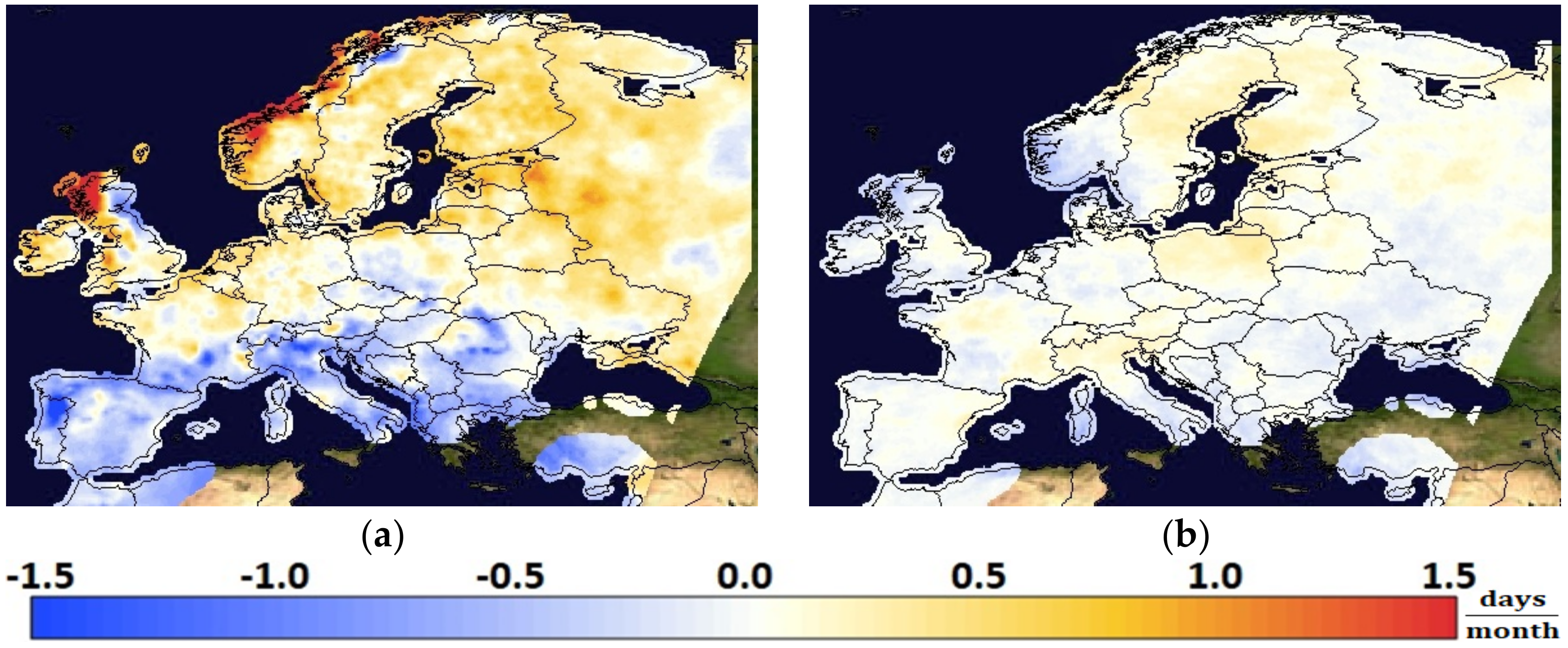
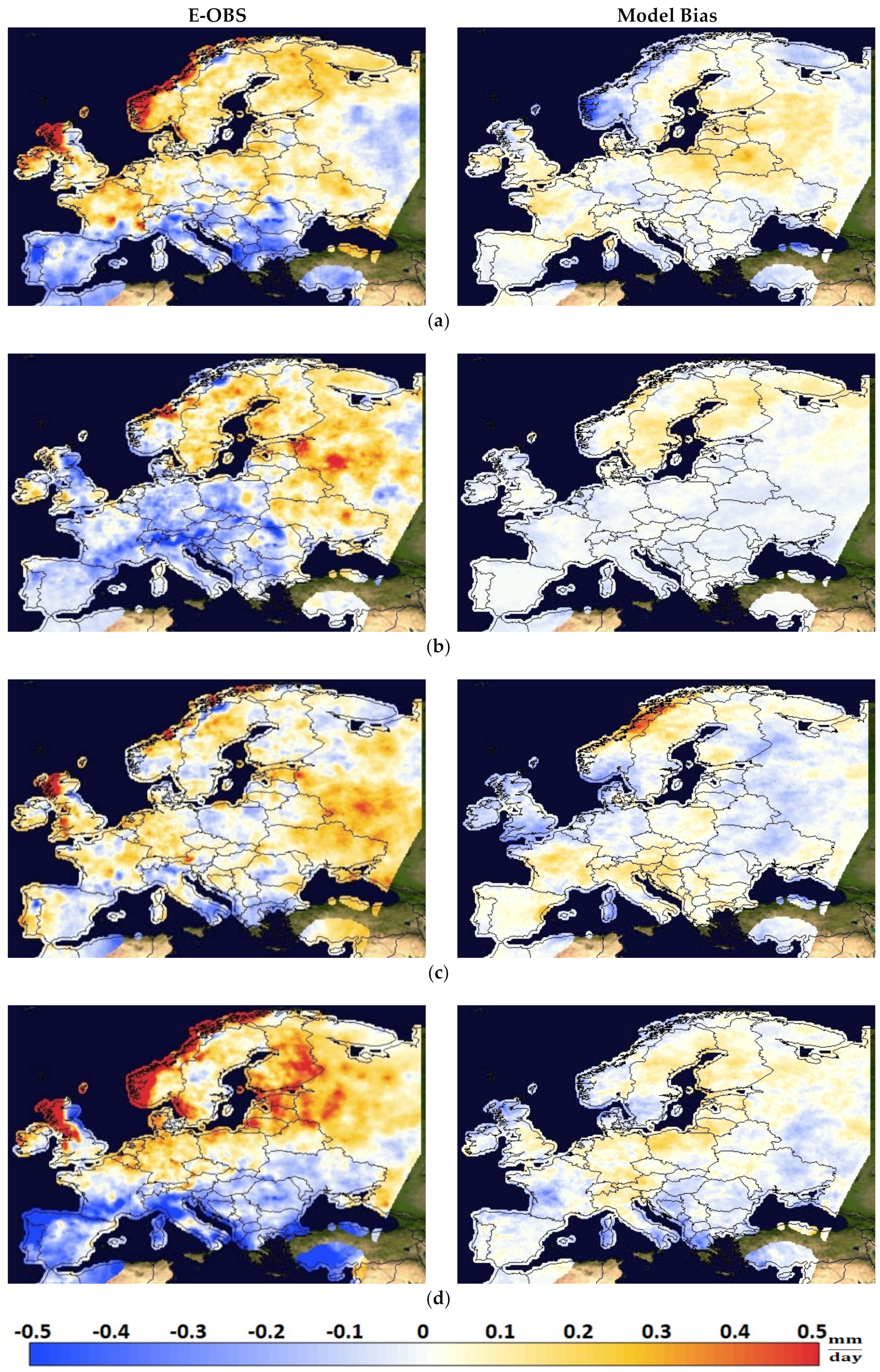
| Temperature | Mean temperature |
| Days/month with mean temperature over 25 °C | |
| Precipitation | Mean precipitation |
| Days/month with precipitation over 5mm |
| Area | Observed Temperature Change between Current and Historic Periods | Model Bias |
|---|---|---|
| EUROPE | 0.7 | 0.2 |
| BI | 0.5 | 0.1 |
| IP | 0.8 | 0.4 |
| FR | 0.7 | 0.3 |
| ME | 0.7 | 0.2 |
| SC | 0.7 | 0.2 |
| AL | 0.7 | 0.3 |
| MD | 0.5 | 0.3 |
| EE | 0.6 | 0.2 |
| Spring | Summer | Autumn | Winter | |||||
|---|---|---|---|---|---|---|---|---|
| Area | Observed Temperature Change between Current and Historic Periods | Model Bias | Observed Temperature Change between Current and Historic Periods | Model Bias | Observed Temperature Change between Current and Historic Periods | Model Bias | Observed Temperature Change between Current and Historic Periods | Model Bias |
| EUROPE | 0.9 | 0.1 | 0.6 | 0.3 | 0.4 | 0.1 | 0.8 | 0.6 |
| BI | 0.6 | 0.1 | 0.6 | 0.1 | 0.3 | 0.0 | 0.5 | 0.3 |
| IP | 0.8 | 0.2 | 1.1 | 0.8 | 0.6 | 0.3 | 0.5 | 0.3 |
| FR | 0.8 | 0.1 | 1.1 | 0.6 | 0.6 | 0.1 | 0.5 | 0.3 |
| ME | 1.0 | 0.0 | 0.9 | 0.3 | 0.4 | 0.0 | 0.7 | 0.4 |
| SC | 1.0 | 0.0 | 0.3 | 0.1 | 0.3 | 0.1 | 1.2 | 0.8 |
| AL | 0.7 | 0.2 | 1.1 | 0.4 | 0.4 | 0.1 | 0.5 | 0.5 |
| MD | 0.6 | 0.4 | 0.9 | 0.3 | 0.4 | 0.1 | 0.2 | 0.3 |
| EE | 1.0 | 0.2 | 0.5 | 0.1 | 0.1 | 0.1 | 0.8 | 0.6 |
| Area | Observed Precipitation Change between Current and Historic Periods | Model Bias |
|---|---|---|
| EUROPE | 0.1 | 0.0 |
| BI | 0.2 | 0.0 |
| IP | −0.2 | 0.0 |
| FR | 0.0 | 0.0 |
| ME | 0.1 | 0.0 |
| SC | 0.2 | 0.0 |
| AL | −0.1 | 0.1 |
| MD | −0.2 | 0.0 |
| EE | 0.0 | 0.0 |
| Spring | Summer | Autumn | Winter | |||||
|---|---|---|---|---|---|---|---|---|
| Area | Observed Precipitation Change between Current and Historic Periods | Model Bias | Observed Precipitation Change between Current and Historic Periods | Model Bias | Observed Precipitation Change between Current and Historic Periods | Model Bias | Observed Precipitation Change between Current and Historic Periods | Model Bias |
| EUROPE | 0.1 | 0.0 | 0.0 | 0.0 | 0.1 | 0.0 | 0.1 | 0.0 |
| BI | 0.3 | 0.0 | 0.0 | 0.0 | 0.3 | −0.1 | 0.3 | 0.0 |
| IP | −0.2 | 0.0 | −0.1 | 0.0 | 0.0 | 0.0 | −0.4 | 0.0 |
| FR | 0.2 | 0.1 | −0.1 | 0.0 | 0.1 | 0.0 | −0.1 | 0.0 |
| ME | 0.1 | 0.0 | −0.1 | 0.0 | 0.2 | 0.0 | 0.2 | 0.0 |
| SC | 0.2 | 0.0 | 0.2 | 0.1 | 0.1 | 0.0 | 0.3 | 0.0 |
| AL | 0.0 | 0.0 | −0.3 | 0.0 | 0.1 | 0.1 | −0.2 | 0.1 |
| MD | −0.1 | 0.0 | −0.1 | −0.1 | −0.1 | 0.0 | −0.3 | −0.2 |
| EE | 0.0 | 0.1 | 0.0 | −0.1 | 0.1 | 0.0 | 0.0 | 0.0 |
Publisher’s Note: MDPI stays neutral with regard to jurisdictional claims in published maps and institutional affiliations. |
© 2022 by the authors. Licensee MDPI, Basel, Switzerland. This article is an open access article distributed under the terms and conditions of the Creative Commons Attribution (CC BY) license (https://creativecommons.org/licenses/by/4.0/).
Share and Cite
Stergiou, I.; Tagaris, E.; Sotiropoulou, R.-E.P. Temperature and Precipitation Bias Patterns in a Dynamical Downscaling Procedure over Europe during the Period 1951–2010. Atmosphere 2022, 13, 1338. https://doi.org/10.3390/atmos13081338
Stergiou I, Tagaris E, Sotiropoulou R-EP. Temperature and Precipitation Bias Patterns in a Dynamical Downscaling Procedure over Europe during the Period 1951–2010. Atmosphere. 2022; 13(8):1338. https://doi.org/10.3390/atmos13081338
Chicago/Turabian StyleStergiou, Ioannis, Efthimios Tagaris, and Rafaella-Eleni P. Sotiropoulou. 2022. "Temperature and Precipitation Bias Patterns in a Dynamical Downscaling Procedure over Europe during the Period 1951–2010" Atmosphere 13, no. 8: 1338. https://doi.org/10.3390/atmos13081338
APA StyleStergiou, I., Tagaris, E., & Sotiropoulou, R.-E. P. (2022). Temperature and Precipitation Bias Patterns in a Dynamical Downscaling Procedure over Europe during the Period 1951–2010. Atmosphere, 13(8), 1338. https://doi.org/10.3390/atmos13081338








